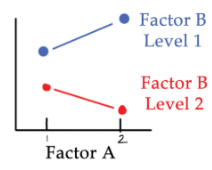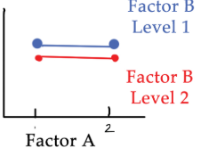STAT 230 MIDTERM 2
1/67
Earn XP
Description and Tags
EAT DOWN OK AMELIA AND DONT CRY OR KILL YOURSELF LIFE IS ROBLOX
Name | Mastery | Learn | Test | Matching | Spaced |
|---|
No study sessions yet.
68 Terms
Observed
Xijk
What is xijk?
observed value for the kth observation under the ith level of factor A and jth level of factor B
ai
effect of the ith level of factor A
μ
grand mean
Bj
effect of the jth level of factor B
(aB)ij
the interaction effect between level i of factor A and level j of Factor B
eijk
error/residual
C
Unknown true values are constant
A
components go together to make xijk by adding them
Z
The errors have a mean of zero. eg. E{εijk} = 0
S
errors (εijk) come from the same distribution, with
common standard deviation
I
errors are independent (eg. there is no relationship
between ε111 and ε112)
N
the distribution of εijk is Normal
Two assumptions about unknown true values
C and A
Four assumptions about errors:
Z, S, I, and N
SSCorrected Total =
SSTotal − SSMean
√MSE =
whatever is the SD for this analysis. This is the estimate
of σε, the standard deviation of the ε’s
Hypotheses to test in a BF[1] design
H0 : α1 = α2 = · · · = αg = 0
vs.
Ha: At least one αi is different from the others
Test H0 for BF[1]
F-ratio
F-ratio = MSgroup/MSError = Variability due to group/Variability due to error = (One estimate of
chance error variability + Estimate of variability due to groups)/Another estimate
of chance error
MSError
quantifies variability due to error
η2
interpreted as the percent of the
variability in the response that can be explained..
η2model =
SSexplained/ SSCorrectedTotal
η2FactorA=
SSFactorA/SSCorrectedTotal
η2p
calculated to quantify the percent of the
variability explained by a single effect AFTER controlling for the variability explained by other factors:
η2p,FactorA =
SSFactorA/(SSFactorA + SSE)
where SSE is the SS for the error used to test Factor A
For BF[1] models, η2 =
η2p
Why randomize:
Protect against bias and confounding
2 Allows us to use probability and sampling distributions when
analyzing the data.
Balance refers to
the presence of equal treatment group size
Partition
a way of sorting them into groups.
Factor
a meaningful partition of the observations
To find power, we need:
1 α (significance level)
2 n (observations per group)
3 I (number of groups)
4 values for α1, α2, . . . , αI
5 estimate of σ2
F-test does NOT
help you see which means are different or best.
comparison is
a measure of distance between means for two
groups of observed values.
What do we use if we want to check if the true difference equal to zero?
hypothesis test
What do we use if we want to check if the range of plausible values for true difference
CI
two groups for comparison
µ1. − µ2.
3 groups for comparison
µ1. − µ2.
µ1. − µ3.
µ2. − µ3.
5 groups for comparison
µ1. − µ2.
µ1. − µ3.
µ2. − µ3.
µ1. − µ4.
µ2. − µ4.
µ3. − µ4.
µ1. − µ5.
µ2. − µ5.
µ3. − µ5.
µ4. − µ5.
Family-wise (Type I) error rate
The chance of at least one ___error among a ____
of tests, assuming there are no differences in the group means.
“contrasts” of the form c1µ1. + c2µ2. + ... + cIµI.
µ1. − (µ2. + µ3. + µ4. + µ5/4) ⇒ 1 -.25 -.25 -.25 -.25
orthogonal)
perpendicular/non-overlapping information. Totally distinct comparisons
can use a set of orthogonal contrasts to
split the SS for a factor into pieces, one piece for each contrast
Looking at multiple factors simultaneously allows us to:
1 Study the factors in one experiment instead of multiple experiments
2 Study how conditions interact
Two factors are crossed if
all possible combinations of the factors’ levels occur in the design.
Interaction
the effect of factor A on the response changes for different values of factor B.
BF[2]
yijk = µ + αi + βj + (αβ)ij + εijk
Three Null Hypotheses
H0: The mean wear for the 2 filler types is the same ← check main
effect for filler
–OR–
H0: α1 = α2 = 0
H0: The mean wear for the 3 proportions is the same ← check main
effect for filler
–OR–
H0: β1 = β2 = β3 = 0
H0: Proportion and Filler do NOT interact ← check interaction effect
H0: (αβ)11 = (αβ)12 = (αβ)13 = (αβ)21 = (αβ)22 = (αβ)23 = 0
Assessing the interaction requires
a response and two crossed factors Use an interaction plot
BF[2] Decomposition: Observed values
= Cell means + Residuals
BF[2] Decomposition: Cell means
estimated mean effect = factor level mean - grand mean
BF[2] Decomposition: Interaction effect
= cell mean - (grand mean + factor A effect + factor B effect)
The meaning of a main effect changes
if there is a significant interaction.
If interaction IS significant
Compare treatment means (are main effects meaningful)
If interaction is NOT significant
Evaluate and interpret main effects

p value for interaction is 0.01
p value for factor B is 0.90

pvalue for interaction is 0.01
p value for factor B is 0.01

p value for interaction is 0.90
pvalue for factor B is 0.20
Replication is important because
1 gives more precision to our estimates of model parameters
2 gives us information about the errors εij, which then allows us to make inference about model parameters.
what if there there is not replication?
Hope that the prop×filler interaction is non-existant/non-significant
if there is no interaction effect
MSinterax is just an estimate of σ2 (i.e., MSinterax ∼= σ2) . . . just run the model with no interaction term
UNBALANCED DATA:
Standard formula for estimating model parameters are often invalid
Order of the factors in the model affects SS, MS, and F-tests
Type I SS
gives first term in the model the chance to “explain” as much of the variability as possible, with 2nd, 3rd, and later terms a chance to explain what is leftover (Type I SS aka “Sequential SS")
Type III SS
which treats each term as if it were last in the model. That is, what is unique about this term after explaining all others (aka “SS Last”)
Type II SS
which gives the effect of each main effect in the presence of all other main effects, but before the two-way interaction(s); then it gives the effect of the interactions in the presence of the main effects and any other interactions of the same order.
For Type III and Type II SSModel /=
SSGender + SSType + SSInteraction